Study on the Microscopic Mechanism of Grouting in Saturated Water-Bearing Sand Stratum Based on VOF-DEM Method
Abstract
:1. Introduction
2. Methods
2.1. Governing Equations for the Particle Phase
2.2. Governing Equations for the Fluid Phase
2.3. Fluid–Particle Interaction Force
2.4. Implementation of Coupled VOF–DEM Model
3. Simulation Parameters of Sandy Soil
4. Calculation Model and Parameters
5. Analysis of Calculation Results
- Compaction diffusion mechanism: Due to the dislocation of sandy soil particles and the formation of only slurry, it did not contain a sandy soil compaction zone.
- Permeation diffusion mechanism: The slurry flows in the pores of the sandy soil did not seriously change the microstructure of the sandy soil.
- The larger compaction zone made the diffusion center of the slurry move downward.
- The slurry diffusion was influenced by gravity due to the low viscous resistance of loose sand to the slurry.
6. Conclusions
- (1)
- In dense sands, the permeation diffusion of the slurry dominated, whereas in loose sands, the compaction zone was well developed.
- (2)
- The evolution of the force chain state during grouting indicates the loose sand had a wider propagation of stress and the dense sand had a larger increase in the stress state. The diffusion model of the slurry changed from compaction diffusion dominated by permeation diffusion to permeation diffusion dominated by compaction diffusion.
- (3)
- The slurry diffusion range and injected grout volume show that the larger the grouting pressure and the larger the sand layer porosity the more favorable the slurry diffusion. When the sand layer porosity was small, the slurry diffusion phenomenon along the dominant path of the grouting pipe wall boundary was obvious. When the sand layer porosity was larger, the permeation diffusion of the slurry was significantly affected by gravity.
- (4)
- In loose sand, when the grouting pressure was less than 200 kPa, no compaction occurred during the grouting process. In dense sand, when the grouting pressure was less than 500 kPa, no compaction occurred during the grouting process.
Author Contributions
Funding
Institutional Review Board Statement
Informed Consent Statement
Data Availability Statement
Conflicts of Interest
References
- Long, Y.; Tan, Y. Soil arching due to leaking of tunnel buried in water-rich sand. Tunn. Undergr. Space Technol. 2020, 95, 103158. [Google Scholar] [CrossRef]
- Liang, Y.; Chen, X.; Yang, J.; Zhang, J.; Huang, L. Analysis of ground collapse caused by shield tunnelling and the evaluation of the reinforcement effect on a sand stratum. Eng. Fail. Anal. 2020, 115, 104616. [Google Scholar] [CrossRef]
- Saleh, S.; Yunus, N.Z.M.; Ahmad, K.; Ali, N. Improving the strength of weak soil using polyurethane grouts: A review. Constr. Build. Mater. 2019, 202, 738–752. [Google Scholar] [CrossRef]
- Li, S.; Liu, R.; Zhang, Q.; Zhang, X. Protection against water or mud inrush in tunnels by grouting: A review. J. Rock Mech. Geotech. Eng. 2016, 8, 753–766. [Google Scholar] [CrossRef]
- Li, F.; Wang, C.; Xia, Y.; Hao, Y.; Zhao, P.; Shi, M. Strength and Solidification Mechanism of Silt Solidified by Polyurethane. Adv. Civ. Eng. 2020, 2020, 8824524. [Google Scholar] [CrossRef]
- Zhou, Z.; Du, X.; Wang, S. Strength for Modified Polyurethane with Modified Sand. Geotech. Geol. Eng. 2017, 36, 1897–1906. [Google Scholar] [CrossRef]
- Liu, J.; Yuen, K.; Chen, W.; Zhou, X.; Wang, W. Grouting for water and mud inrush control in weathered granite tunnel: A case study. Eng. Geol. 2020, 279, 105896. [Google Scholar] [CrossRef]
- Li, Z.; Zhang, L.; Chu, Y.; Zhang, Q. Research on Influence of Water-Cement Ratio on Reinforcement Effect for Permeation Grouting in Sand Layer. Adv. Mater. Sci. Eng. 2020, 2020, 5329627. [Google Scholar] [CrossRef]
- Wang, D.; Sui, W. Grout diffusion characteristics during chemical grouting in a deep water-bearing sand layer. Int. J. Min. Sci. Technol. 2012, 22, 589–593. [Google Scholar] [CrossRef]
- Wang, Q.; Wang, S.; Sloan, S.W.; Sheng, D.; Pakzad, R. Experimental investigation of pressure grouting in sand. Soils Found. 2016, 56, 161–173. [Google Scholar] [CrossRef]
- Ren, B.; Mu, W.; Jiang, B.; Yu, G.; Li, L.; Wei, T.; Han, Y.; Xiao, D. Grouting Mechanism in Water-Bearing Fractured Rock Based on Two-Phase Flow. Geofluids 2021, 2021, 5585288. [Google Scholar] [CrossRef]
- Cui, W.; Tang, Q.; Song, H. Washout resistance evaluation of fast-setting cement-based grouts considering time-varying viscosity using CFD simulation. Constr. Build. Mater. 2020, 242, 117959. [Google Scholar] [CrossRef]
- Li, S.; Pan, D.; Xu, Z.; Lin, P.; Zhang, Y. Numerical simulation of dynamic water grouting using quick-setting slurry in rock fracture: The Sequential Diffusion and Solidification (SDS) method. Comput. Geotech. 2020, 122, 103497. [Google Scholar] [CrossRef]
- Liu, X.; Wang, F.; Huang, J.; Wang, S.; Zhang, Z.; Nawnit, K. Grout diffusion in silty fine sand stratum with high groundwater level for tunnel construction. Tunn. Undergr. Space Technol. 2019, 93, 103051. [Google Scholar] [CrossRef]
- Boschi, K.; di Prisco, C.G.; Ciantia, M.O. Micromechanical investigation of grouting in soils. Int. J. Solids Struct. 2020, 187, 121–132. [Google Scholar] [CrossRef]
- Yang, C.; Guo, J.; Lian, J.; Wang, Z. Study on Microscopic Roadbed Grouting Mechanism Based on CFD-DEM Coupling Algorithm. Math. Probl. Eng. 2020, 2020, 4948738. [Google Scholar] [CrossRef]
- Guo, W.; Zhang, M.; Sun, Y.; Li, Q.; Zhao, S.; Deng, S. Numerical simulation and field test of grouting in Nong’an pilot project of in-situ conversion of oil shale. J. Pet. Sci. Eng. 2020, 184, 106477. [Google Scholar] [CrossRef]
- Cundall, P.; Strack, O. Discussion: A discrete numerical model for granular assemblies. Geotechnique 1979, 30, 331–336. [Google Scholar] [CrossRef]
- Hertz, H. On the contact of elastic solids. J. Reine. Angew. Math 1881, 92, 156–171. [Google Scholar]
- Mindlin, R.; Deresiewicz, H. Elastic Spheres in Contact under Varying Oblique Forces. J. Appl. Mech. 1953, 20, 327–344. [Google Scholar] [CrossRef]
- Mindlin, R. Compliance of Elastic Bodies in Contact. J. Appl. Mech. 1949, 16, 259–268. [Google Scholar] [CrossRef]
- Tsuji, Y.; Tanaka, T.; Ishida, T. Lagrangian numerical simulation of plug flow of cohesionless particles in a horizontal pipe. Powder Technol. 1992, 71, 239–250. [Google Scholar] [CrossRef]
- Cundall, P.A. A computer model for simulating progressive, large-scale movement in blocky rock system. In Proceedings of the International Symposium on Rock Mechanics, Nancy, France, 4–6 October 1971. [Google Scholar]
- Sakaguchi, H.; Ozaki, E.; Igarashi, T. Plugging of the flow of granular materials during the discharge from a silo. Int. J. Mod. Phys. B 1993, 7, 1949–1963. [Google Scholar] [CrossRef]
- Anderson, T.; Jackson, R. A Fluid Mechanical Description of Fluidized Beds. Ind. Eng. Chem. Fundam. 1967, 6, 527–539. [Google Scholar] [CrossRef]
- Ibrahim, A.; Meguid, M.A. Coupled Flow Modelling in Geotechnical and Ground Engineering: An Overview. Int. J. Geosynth. Ground Eng. 2020, 6, 39. [Google Scholar] [CrossRef]
- Di Felice, R. The voidage function for fluid-particle interaction systems. Int. J. Multiph. Flow 1994, 20, 153–159. [Google Scholar] [CrossRef]
- Wu, L.; Gong, M.; Wang, J. Development of a DEM–VOF Model for the Turbulent Free-Surface Flows with Particles and Its Application to Stirred Mixing System. Ind. Eng. Chem. Res. 2018, 57, 1714–1725. [Google Scholar] [CrossRef]
- Zhou, L.; Gao, J.; Hu, C.; Li, Q. Numerical simulation and testing verification of the interaction between track and sandy ground based on discrete element method. J. Terramechanics 2021, 95, 73–88. [Google Scholar] [CrossRef]
- Ghazavi, M.; Hosseini, M. A Comparison between Angle of Repose and Friction Angle of Sand. In Proceedings of the 12th International Conference of International Association for Computer Methods and Advances in Geomechanics (IACMAG), Goa, India, 1–6 October 2008; Volume 2. [Google Scholar]
- Grabowski, A.; Nitka, M.; Tejchman, J. Micro-modelling of shear localization during quasi-static confined granular flow in silos using DEM. Comput. Geotech. 2021, 134, 104108. [Google Scholar] [CrossRef]
- Zhang, D.; Gao, C.; Yin, Z. CFD-DEM modeling of seepage erosion around shield tunnels. Tunn. Undergr. Space Technol. 2019, 83, 60–72. [Google Scholar] [CrossRef]
- Zeng, H.; Xu, W.; Zang, M.; Yang, P.; Guo, X. Calibration and validation of DEM-FEM model parameters using upscaled particles based on physical experiments and simulations. Adv. Powder Technol. 2020, 31, 3947–3959. [Google Scholar] [CrossRef]
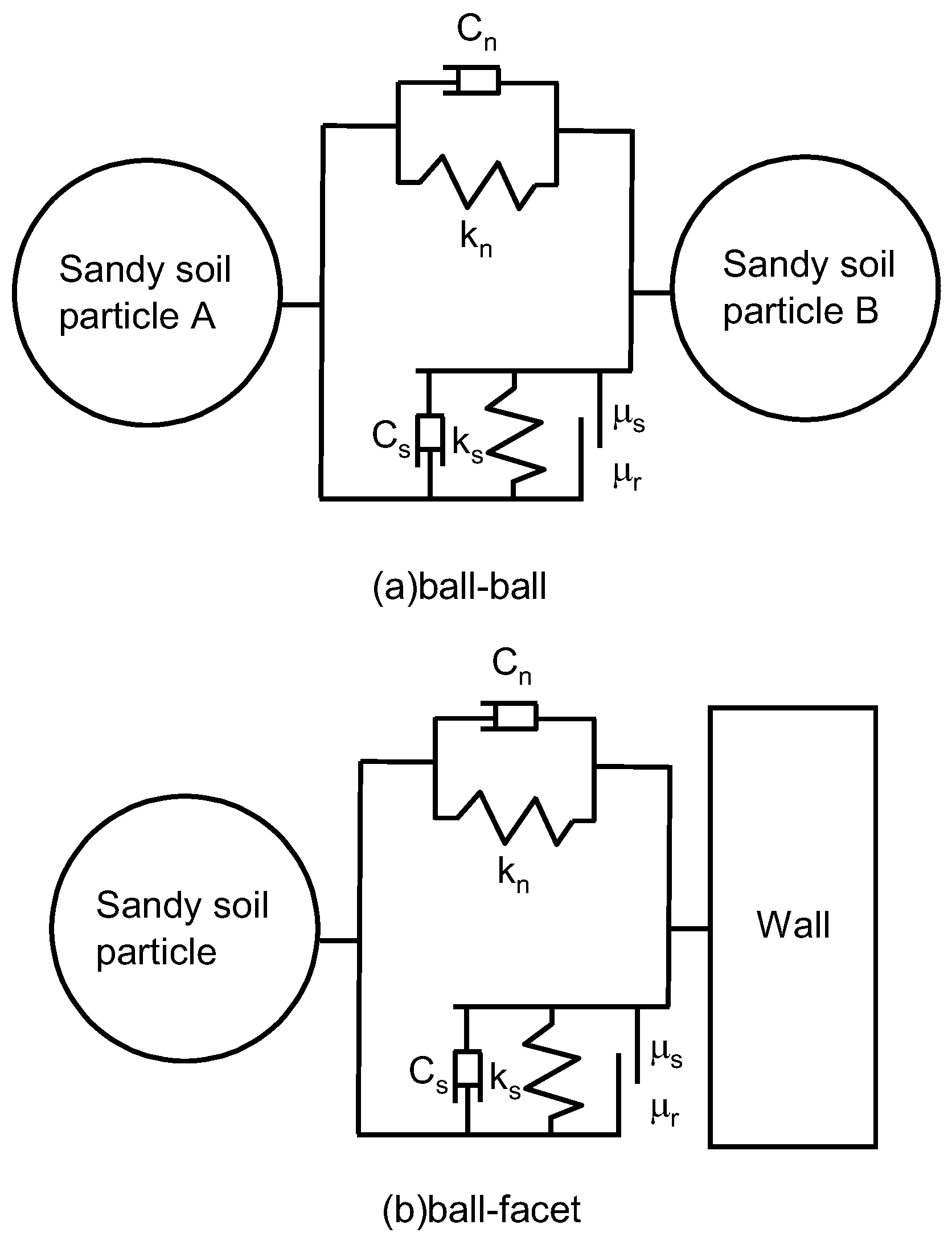
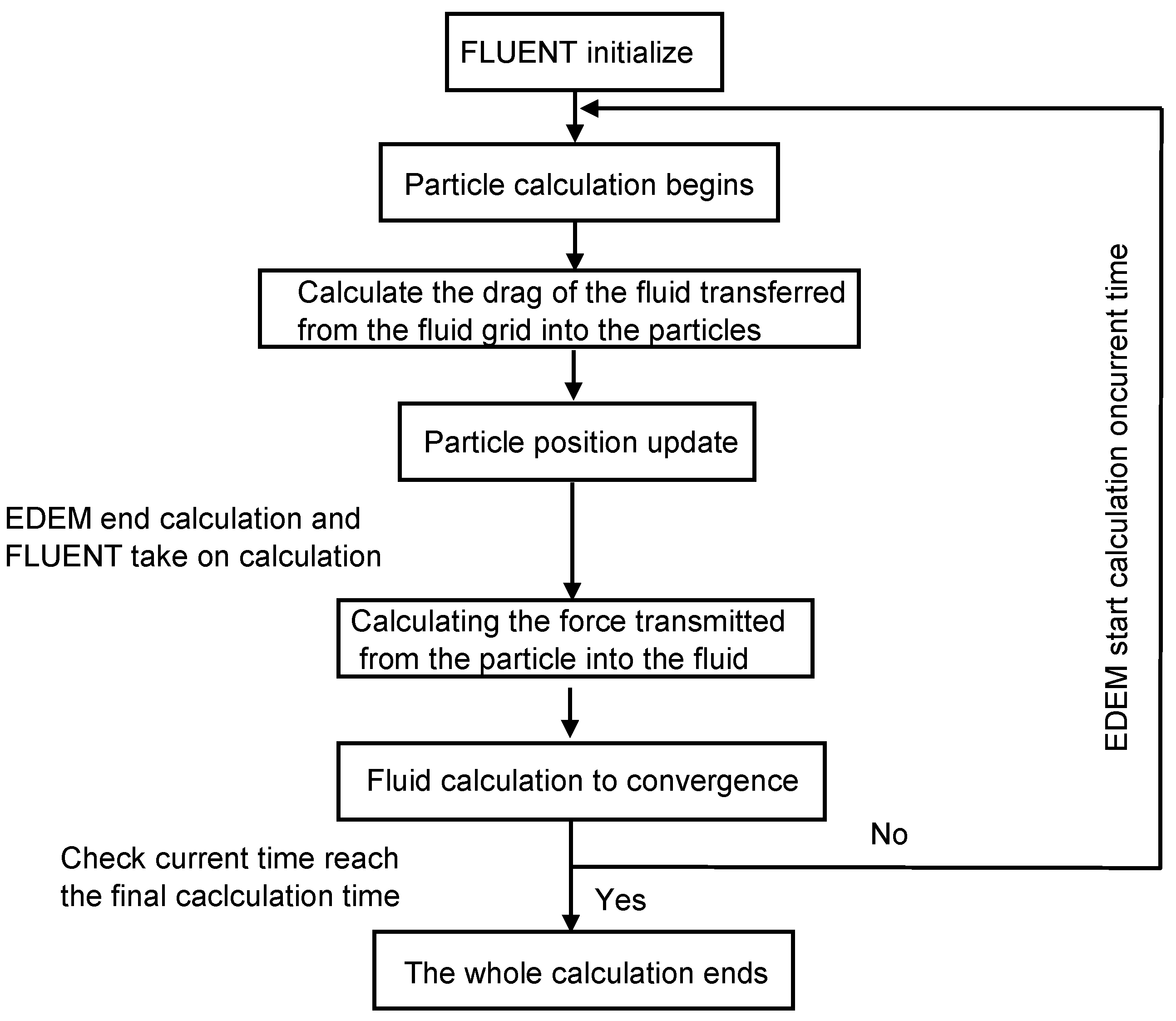
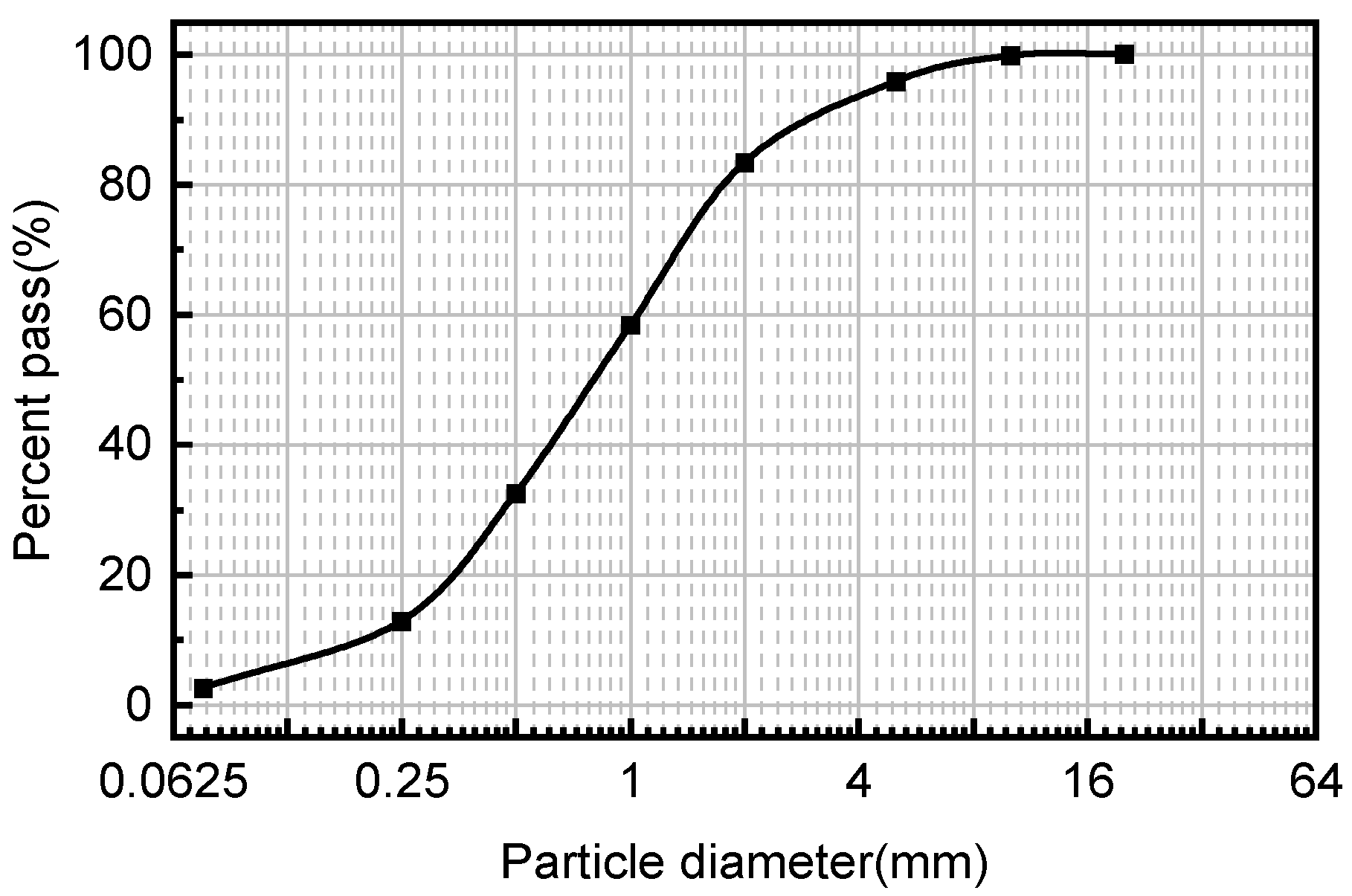

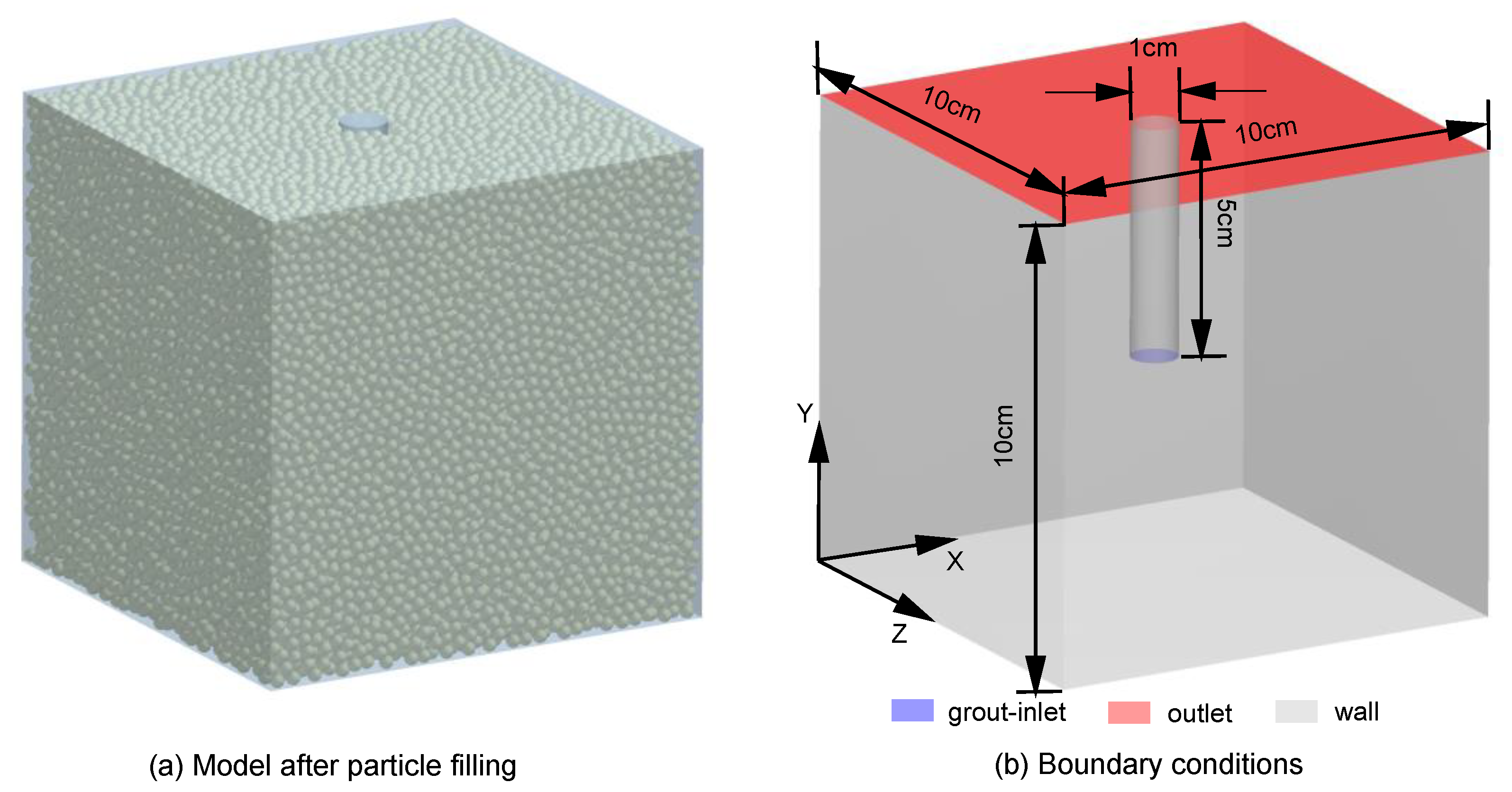

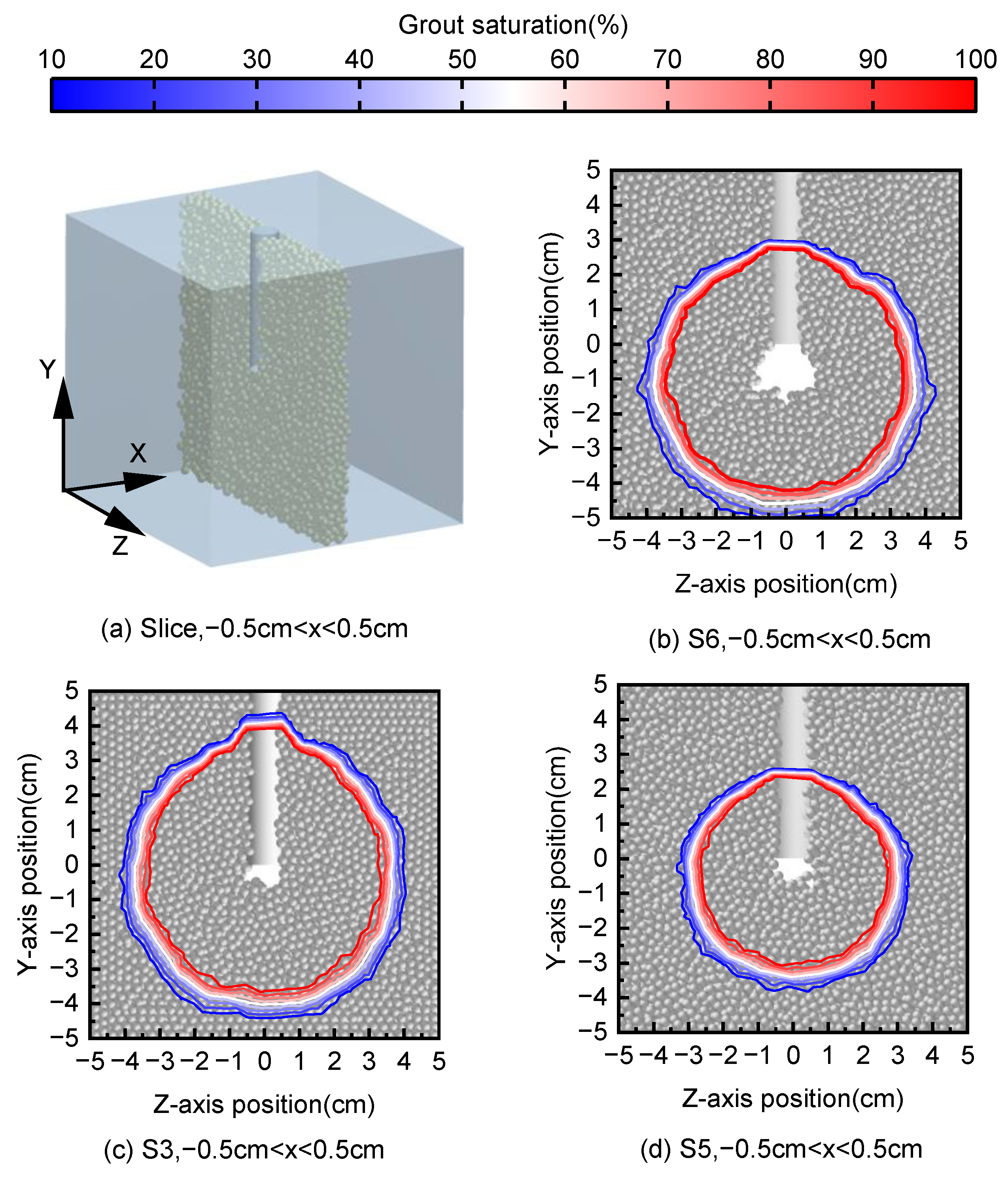

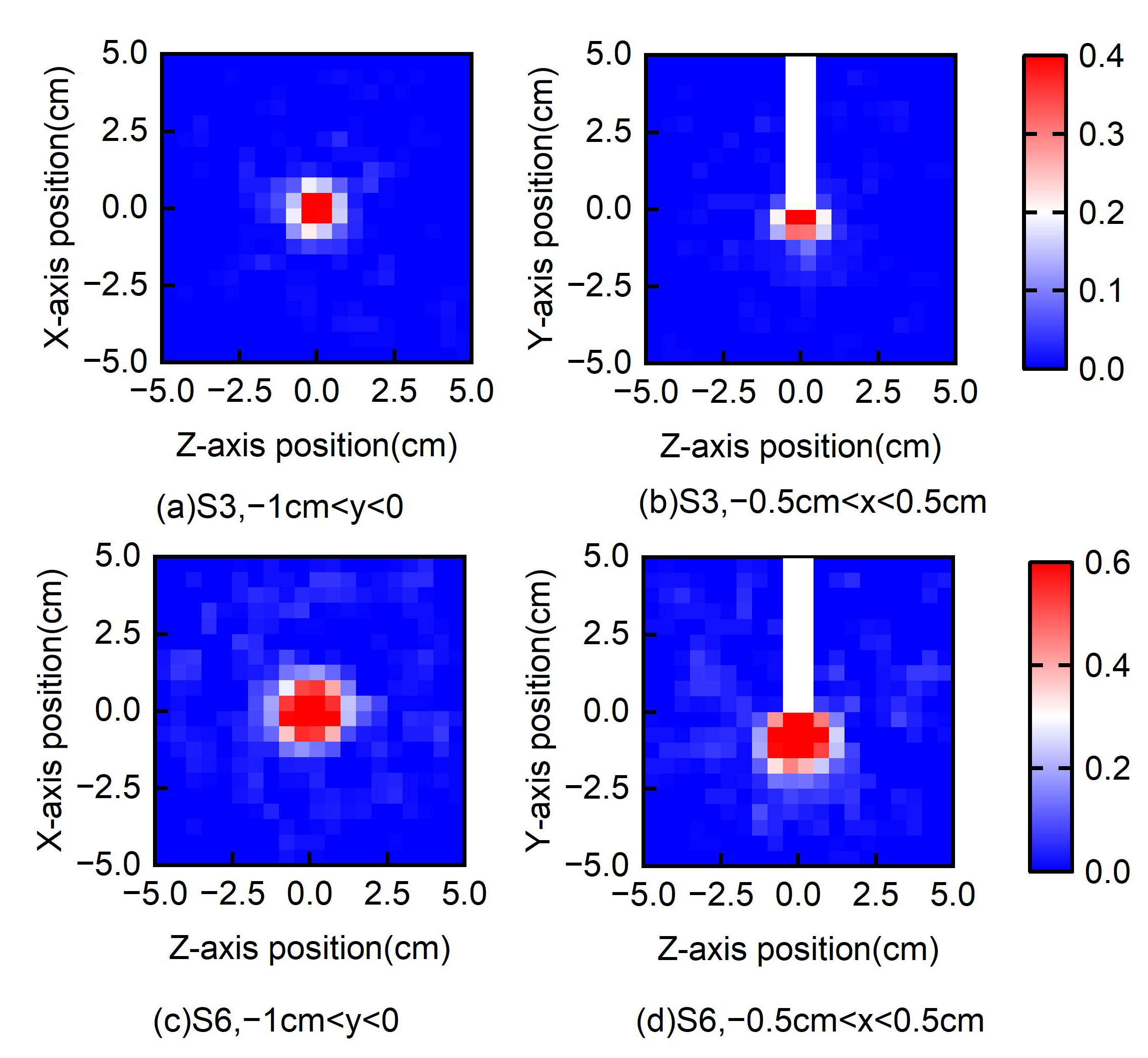
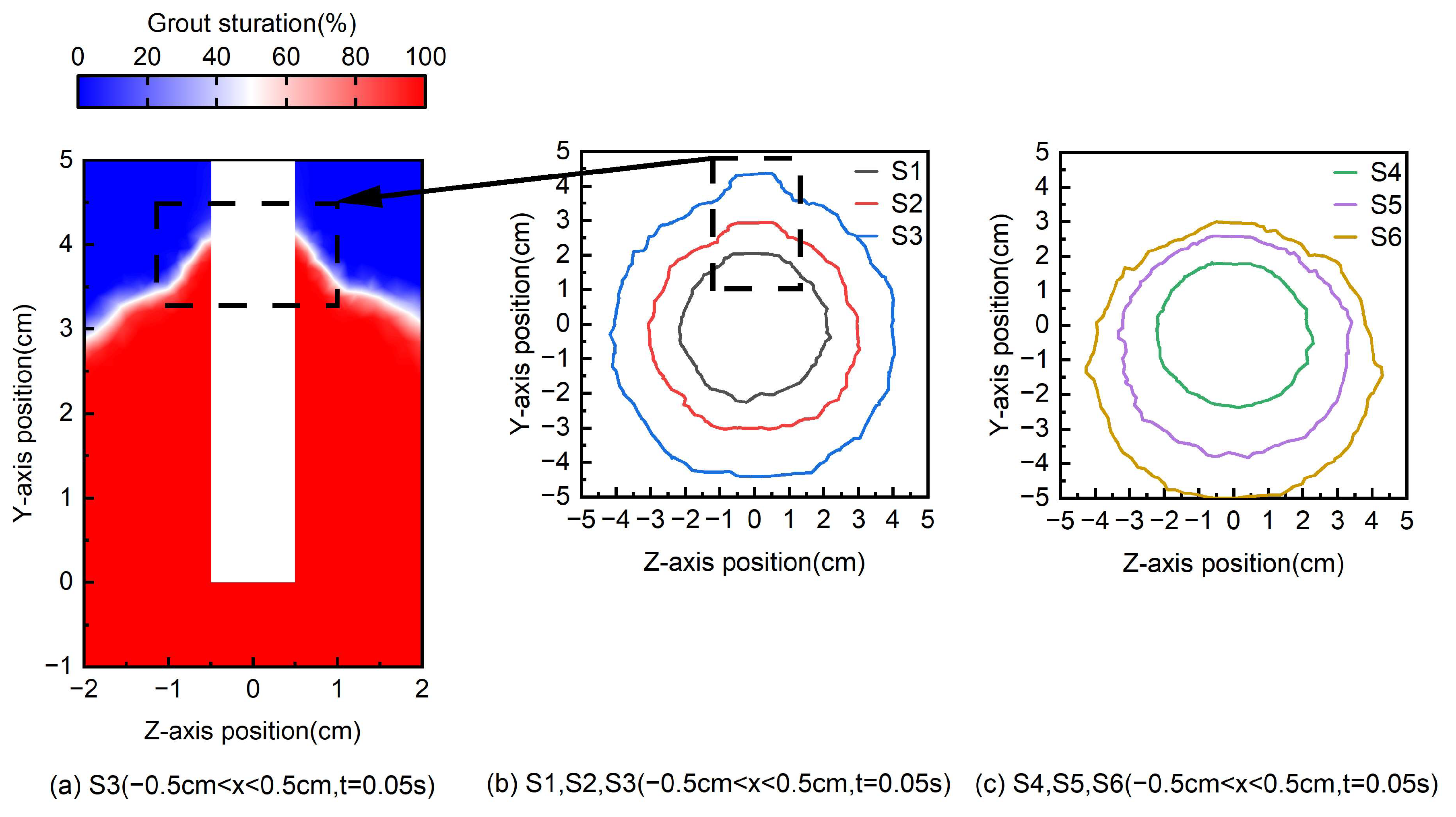
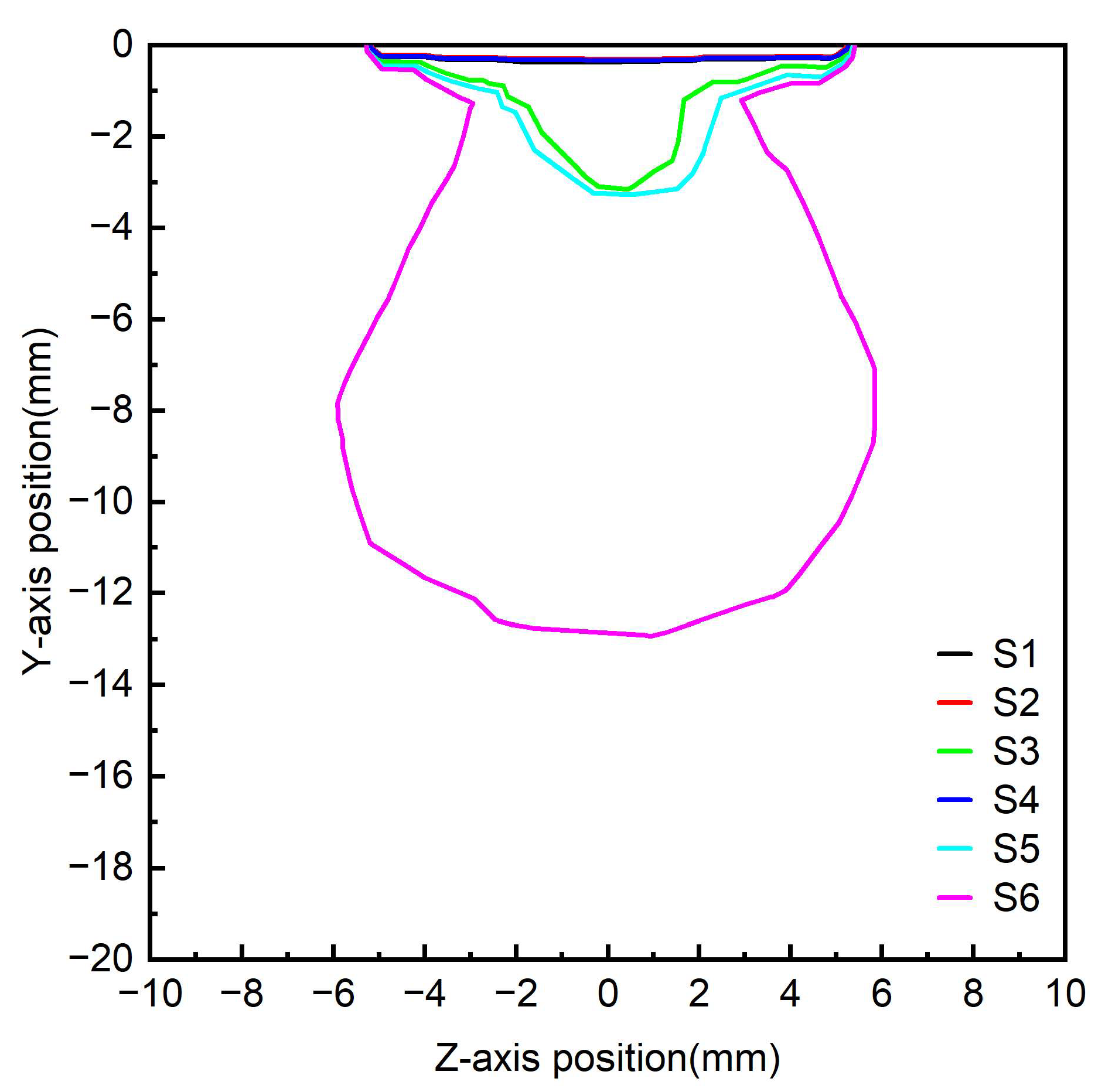


| Contact Model | Hertz–Mindlin (No Slip) |
|---|---|
| Particle diameter (mm) | 2.86 |
| Density (kg/m3) | 2600 |
| Poisson’s ratio | 0.3 |
| Shear modulus (MPa) | 10 |
| Coefficient of restitution | 0.5 |
| Coefficient of static friction | 0.5 |
| Coefficient of rolling friction | 0.3 |
| Fluid | ρ (kg/m³) | μ (Pa·s) |
|---|---|---|
| Cement slurry | 1510 | 0.0123 |
| Water | 1000 | 0.001 |
| Scheme | nsand (-) | Pinj (kPa) |
|---|---|---|
| 1 | 0.3 | 50 |
| 2 | 0.3 | 200 |
| 3 | 0.3 | 500 |
| 4 | 0.4 | 50 |
| 5 | 0.4 | 200 |
| 6 | 0.4 | 500 |
| Scheme | l [mm] | lc [mm] | CR [%] |
|---|---|---|---|
| 1 | 22.6 | 0 | 0 |
| 2 | 30 | 0 | 0 |
| 3 | 44.1 | 3.2 | 7.25 |
| 4 | 23.8 | 0 | 0 |
| 5 | 37.1 | 3.3 | 8.89 |
| 6 | 50.0 | 12.9 | 25.8 |
Publisher’s Note: MDPI stays neutral with regard to jurisdictional claims in published maps and institutional affiliations. |
© 2022 by the authors. Licensee MDPI, Basel, Switzerland. This article is an open access article distributed under the terms and conditions of the Creative Commons Attribution (CC BY) license (https://creativecommons.org/licenses/by/4.0/).
Share and Cite
Li, H.; Ji, X.; Zhou, P. Study on the Microscopic Mechanism of Grouting in Saturated Water-Bearing Sand Stratum Based on VOF-DEM Method. Processes 2022, 10, 1447. https://doi.org/10.3390/pr10081447
Li H, Ji X, Zhou P. Study on the Microscopic Mechanism of Grouting in Saturated Water-Bearing Sand Stratum Based on VOF-DEM Method. Processes. 2022; 10(8):1447. https://doi.org/10.3390/pr10081447
Chicago/Turabian StyleLi, Hui, Xiaoming Ji, and Pengqing Zhou. 2022. "Study on the Microscopic Mechanism of Grouting in Saturated Water-Bearing Sand Stratum Based on VOF-DEM Method" Processes 10, no. 8: 1447. https://doi.org/10.3390/pr10081447
APA StyleLi, H., Ji, X., & Zhou, P. (2022). Study on the Microscopic Mechanism of Grouting in Saturated Water-Bearing Sand Stratum Based on VOF-DEM Method. Processes, 10(8), 1447. https://doi.org/10.3390/pr10081447






